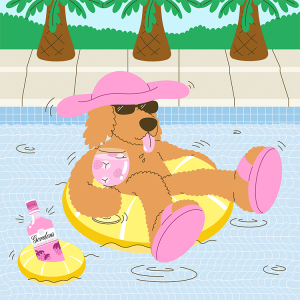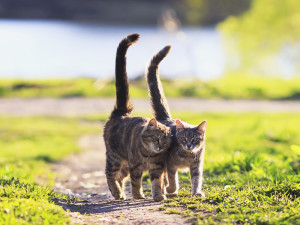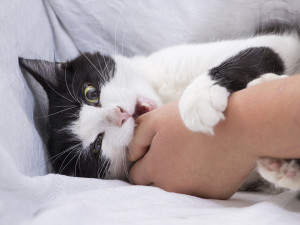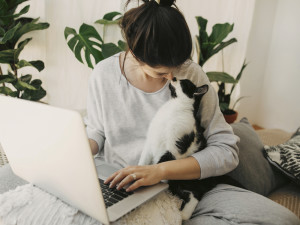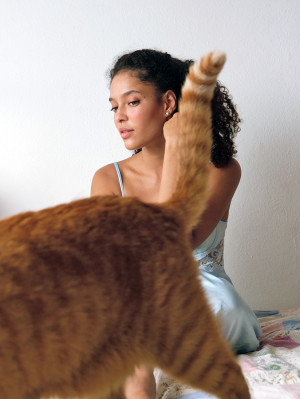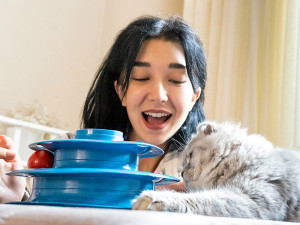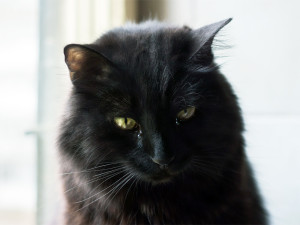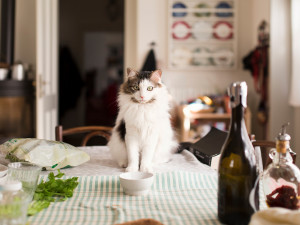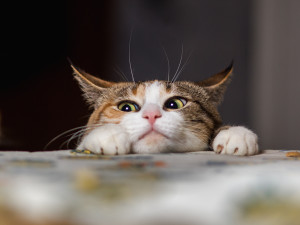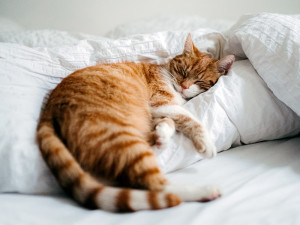Can Cats Smile? 5 Signs of Really Happy Cats
My, what lovely teeth they have...
In This Article:
How Do Cats Smile? The Science Behind Feline Facial Expressions What Does a Cat's “Smile” Look Like? 5 Signs of a Happy Cat
While cats may not smile like humans, they can express happiness through facial expressions and body language. Learning to recognize the signs of a happy cat — such as relaxed ears, soft eyes, and a gently curved mouth — can help you understand your kitty’s emotional state.
In fact, this is something that cats already know how to do when it comes to reading their human parents’ emotions. Research has shownopens in new tab that cats are able to recognize and match emotions that are expressed both facially and vocally.
But how well are we able to read our cats emotions? Can cats really smile with happiness, or do we interpret their “smile” as happiness because of our tendency to assign human emotions to animals and even non-living things? Let’s take a deeper look at how our feline friends show their emotions.
How much do you spend on your pet per year?
How do cats smile? The science behind feline facial expressions
Let’s be honest: Cats aren’t known for having exaggerated, obvious facial expressions. Cats evolved in arid regions of the world where resources were not particularly abundant, which meant that territories were large and close encounters with other cats were rare (with the exceptions of mating and rearing young). As a result, cats did not have much need to develop facial musculature specifically to display their emotional state. This is different than humans or dogs, who evolved in groups and use facial expressions to clearly convey how we are feeling.
To communicate their emotions, cats instead rely on more obvious body cues, including tail and ear positioning, body posture, and vocalizations, like hissing and growling. These communication methods are able to be read from afar, thereby keeping potential predators or other kitty competitors at a distance with visual and auditory warnings. I mean, if a cat is pissed off or afraid of something, I don’t want to have to get too close in order to figure that out. I’ll take plenty of distance between me and an angry cat, thank you.
Does that mean cats don’t convey their emotions using facial expressions? Nope! Cats can say a lot with their faces, but it might not be exactly what we think. Cats use their ears, brow, eyes, whiskers, and yes — mouth — to show how they’re feeling. Unfortunately, those things can be tricky to interpret, given all the fur and cuteness that cats possess.
What does a cat’s “smile” look like?
A cat’s mouth can curve in a smile shape, particularly when a cat is relaxed and happy. My cat Samantha will often have the biggest “smile” on her face as she naps. But I wouldn’t exactly say that she’s smiling; I would say that the muscles around her mouth are relaxed in such a way that a smile forms.
Relaxed, slow-blinking eyes
When it comes down to it, cats smile more with their eyesopens in new tab than with their mouth. Have you heard of the “slow blink”? It’s something that cats do - it’s usually a series of half-blinks that is followed by the cat narrowing or even closing their eyes for a longer period of time, and it’s thought to signal relaxation. Research has shown that cats will return slow-blinks with their human parentsopens in new tab and perceive the action in a positive way. Give it a try sometime - send a series of slow-blinks to your cat and see how they respond.
They may even approach you for some petting if you catch them in the right mood. Gentle, slow-blinks are usually welcomed by kitties, as the opposite — hard, direct staring — can be intimidating (as it’s usually the first step in the prey sequence, what cats do when they initiate hunting a prey item).
The grimace scale
What else can a cat’s face tell us? Cats who are relaxed and happy will have facial features positioned differently from cats who are tense or in pain. The grimace scaleopens in new tab is a tool that can be used to assess how much pain a cat is in. For example, a cat whose muzzle is tense and shaped elliptically (as opposed to circular) and has straight whiskers that are directed away from the face may be experiencing severe pain, compared to a kitty whose muzzle and whiskers are more curved and relaxed.
The Flehmen response
And speaking about that mouth area, I should mention the Flehmen Responseopens in new tab. Have you ever seen your cat smell something and then give an open-mouthed huffing kind of reaction, or make what some people call stink-face? This is a response to pheromones that are present, and your cat is using their Jacobson’s organ (located in the roof of the mouth behind the front teeth) to identify what that pheromone is trying to communicate.
Keep your eyes on the ears
Even a cat’s ears have something to say. Ears that are upright and directed forward indicate interest; ears that are flattened to the side or pulled back are shown by cats who may be in a “looky-no-touchy” mood. Airplane ears (flattened to the side) indicate a fearful cat, and ears pulled back indicate anger… and that it’s best to keep your distance.
5 Signs of a happy cat
All of that being said, are you still looking for signs your cat is happy to see you? Check out these five signs of a happy cat and see how many you can check off your list:
Purring and kneading
Purring and kneading while being petted is one of the most recognizable signs that your cat is happy. If you’re thinking my cat smiles when I pet him, you’re probably right, due to the relaxation of those facial muscles that can form a contented lip shape. Purrs and kneading often accompany a cat’s relaxed state!
Relaxed body posture and tail held high
A happy cat has a relaxed stance or posture when standing or laying down. If the cat is standing, a tail held high with a curved tip (like a question mark) indicates that the cat is friendly and may be ready for an interaction with you. I like to think of the cat’s tail as a mood barometer: the higher the tail, the happier the cat (although there are some exceptions, so take other body language indicators into consideration, too).
Further, a cat lying on their side is generally thought to be more relaxed and happy than a cat who is in “loaf” position with their feet exposed and ready to take off at a moment’s notice.
Soft, blinking eyes
And did I already mention slow blinks? Yes, yes I did. I’m mentioning it again, because those slow blinks are an excellent signal that your cat is happy and relaxed, and giving you a big smile! Keep an eye out for them so that you can return your cat’s message of trust and contentedness.
Rubbing against you or “head-bunting”
When a cat rubs against your leg or “head-bunts” you, that’s a cat’s way of marking you with their scent. Happy cats will often mark their people. Plus, it’s a good way for cats to “pet themselves” on the people that they like.
Playful behavior and positive interactions
Cats who are scared or upset don’t play, and happy cats do. They’ve let their inhibitions down and don’t have to worry about being hunted. They are the fearsome, confident hunters when they play! Having friendly interactions with your cat, whether it’s playing, cuddling, or petting not only indicates that a cat is happy, but can also help your cat be happier (if they like those things).
FAQs (People also ask):
How to tell if cats are happy
Positive body language indicators like those mentioned above and pleasant interactions with their people are great signs that cats are happy. But there are other tell-tale signs your cat is happy to see you.
Why is my cat showing teeth?
In humans, a happy grin can include showing off your chompers. However, cats show their teeth for entirely different reasons, which may include not being happy with you. Cats show their teeth when they hiss, and hissing is one of the signs that your cat might be at someone else (or you!).
How do I know if my cat is unhappy with me?
Just like body language and behaviors can indicate whether your cat is happy, body language and actions can also reveal if your cat is unhappy with you. If you think you have a moody cat, it might be time to think about the role you play in your cat’s mental and physical health.


